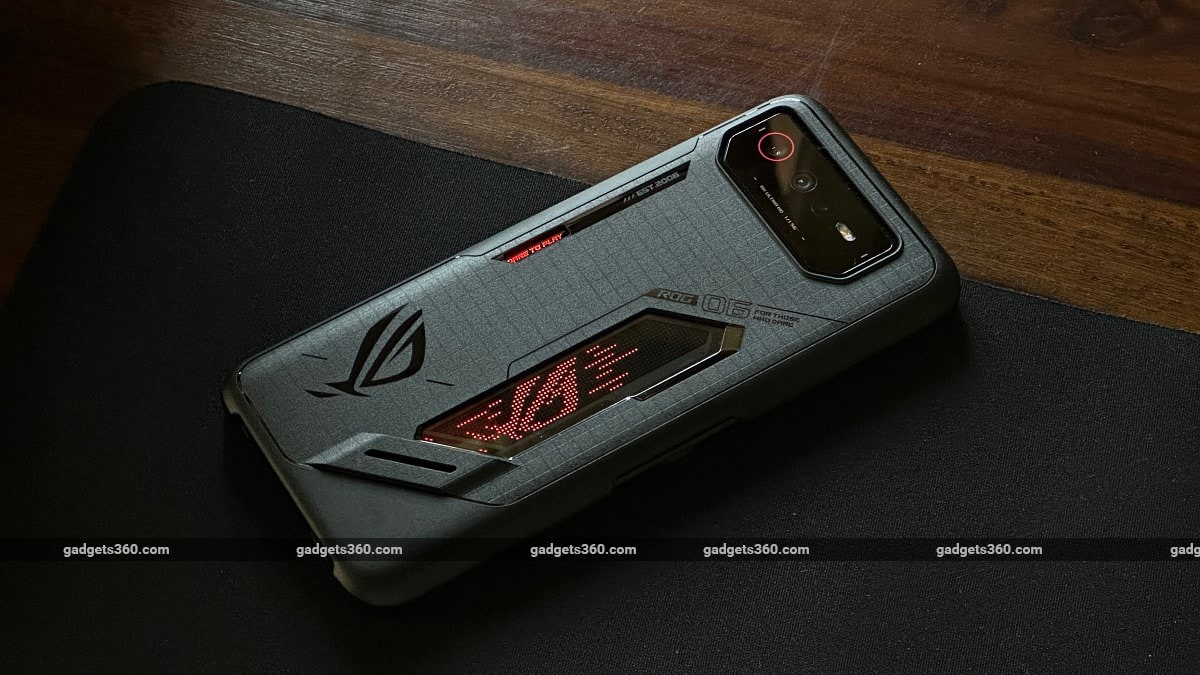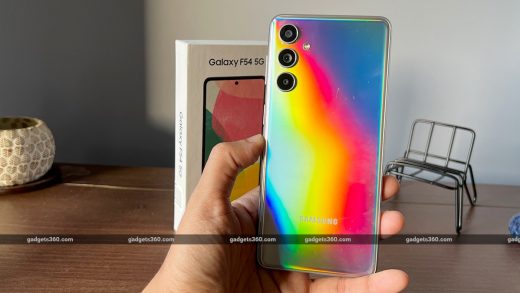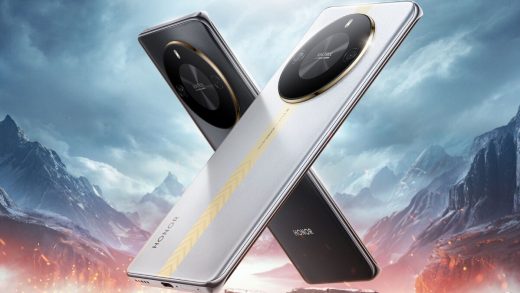
The Asus ROG Phone series has been receiving subtle updates over the years. With gaming brands such as Nubia’s Redmagic and Black Shark leaving the Indian market long ago, Asus’ ROG Phone remains the last phone standing when it comes to high-end, gaming smartphones. This also means that Asus does not really have any direct competition in India and due to that, it can take its time refining its winning formula year on year, without needing to make any drastic changes in order to stay relevant.
The latest Asus ROG Phone 6 isn’t a big leap over its predecessor, the Asus ROG Phone 5s. There are the usual performance-related enhancements which are expected from every new update. There’s a new processor, improvements to the internal cooling system, and a new and an updated cooling accessory. Its design also remains similar to the previous model, only with a couple of changes. But there’s also an improved camera setup, which could make it a premium all-rounder. This last bit is important, given that the ROG Phone 6 has seen a noticeable price hike over the previous model.
Asus ROG Phone 6 price in India
The Asus ROG Phone 6 is priced at Rs. 71,999 for the sole 12GB RAM and 256GB storage configuration. It’s available in two finishes: Storm White and Phantom Black, and I received the latter for this review. There’s also an ROG Phone 6 Pro that’s gone on sale for Rs. 89,999 but the only difference between it and the 6 is a slightly different back panel design with an additional 2-inch OLED display and more RAM (18GB) and storage (512GB). You can read our first impressions of it.
The Asus ROG Phone 6’s price tag is a lot higher than the ROG Phone 5s which was priced at Rs. 57,999 for the 12GB RAM and 256GB storage variant, when launched last year. The price of this year’s base ROG Phone 6 is actually closer to last year’s Pro model which was priced at Rs 79,999.
Combine this increased price tag with Asus’ delayed release in India since the phone was announced in July 2022, and you can see how it needs to be twice as appealing to its niche gamer audience.
Asus ROG Phone 6 design
Part of that appeal seems a bit lost this year, with Asus recycling the same design year after year. Asus keeps taming the design of the ROG Phone every year, but this year appears a bit different. The camera module around the back now protrudes a bit and is quite large compared to previous devices. There’s now two RGB elements in the rear panel. Along with the usual “fearless eye” logo which has gotten the dot-matrix treatment (similar to newer ROG-branded laptops), there’s now a second customisable RGB element under the “Dare to Play” slogan.
![]()
The Asus ROG Phone 6 has two customisable RGB elements on the real panel
The Asus ROG Phone 6’s Gorilla Glass 3 rear panel is still a smudge magnet and the device feels quite chubby with a thickness of 10.3mm, and heavy at 239g (which is quite close to a quarter of kilogram). The ROG Phone 6 finally gets an IPX4 rating. This is good for helping it survive against splashes of water and this brings it a little closer to becoming a proper premium flagship.
However, it’s still quite large and heavy to be used as a daily driver in my opinion, even if you account for its larger than usual battery capacity. Unless you happen to have really large hands, the ROG Phone 6 demands proper, two-handed operation and I wasn’t able to sit comfortably with it in my pants pocket. Even while playing games, the phone feels a bit heavy to hold during extended sessions.
![]()
The Asus ROG Phone 6 has thick bezels at the top and bottom edges of its display
I’m not a fan of razor thin bezels on a smartphone, but the chunky bezels at the top and bottom of the display do appear quite dated for a smartphone launched in 2022. I would have preferred slightly slimmer ones that would have made the device look a bit more modern. Redmagic’s 7S Pro sure looks a lot slicker in comparison with its thinner bezels and the hidden selfie camera (like on the Samsung Galaxy Z Fold 4), which makes for a distraction-free display.
The thick bezels on the Asus ROG Phone 6 do hide the large speakers and so, they have a reason to be there, but it sure takes away from the appeal of the smartphone. In fact, a transparent bezel exposing the hardware below would have definitely looked a lot cooler than the thick black bands at each end.
Asus ROG Phone 6 specifications and software
The processor in the Asus ROG Phone 6 gets upgraded from the Qualcomm Snapdragon 888+ in the ROG Phone 5s to the newer Qualcomm Snapdragon 8+ Gen 1. While the SoC is fairly new, the delayed release of the ROG Phone 6 in India may see a few buyers holding back their purchase until the Snapdragon 8 Gen 2 SoC starts showing up on premium smartphones, some of which are expected to arrive as early as the end of this year.
The ROG Phone 6 offers LPDDR5 RAM and UFS 3.1 storage which is the best that you can get on a premium device. Communication standards include support for multiple 5G bands, Wi-Fi 6, Bluetooth 5.2, NFC, and two USB-Type C ports. There is no dedicated slot for a microSD card but the built-in 256GB of storage should be sufficient. The phone is powered by a 6,000mAh battery and comes with a 30W charger in the box in India. The phone does support up to 65W fast charging, but that charger is sold separately.
![]()
The Console section of the Armoury Crate app lets one tweak and adjust performance settings
The Asus ROG Phone 6 runs Android 12 which has overlays of the brand’s ROG UI and Zen UI. The interface appears typically Asus with ROG UI elements used in the Armoury Crate app, which is where all the gaming-specific hardware adjustments can be made. Tinkerers will love this since you can do anything from adjust the touch sensitivity of the display to tweak the battery performance modes. While the Armoury Crate app appears the same as before, the Game Genie slide-out dashboard has seen an overhaul of sorts.
A swipe from the top-left corner of the display while in a game gives you access to this dashboard, which lets you switch performance modes on the fly and even lets you activate some game-specific settings. While the layout now pops up from the bottom and is much wider, there are still some options or toggles hidden in some scrollable menus, which I did not know about until I accidentally swiped over them.
As for the regular Android software interface, everything is where it should be and runs quite fluidly no matter how many apps or games have been opened in the background. The lack of Android 13 on a smartphone launched towards the end of 2022 stands out like a sore thumb when compared to other flagships at this price point. Asus did not comment about when the update to Android 13 would be available either.
Asus ROG Phone 6 performance
As expected, the Asus ROG Phone 6 performed really well in benchmarks and easily takes down most high-end Android premium flagships. When running most benchmarking apps, the phone forcibly used X Mode, but I managed to get regular scores as well. AnTuTu only ran in X Mode and returned a score of 10,83,480, which is the highest we have seen among the Qualcomm Snapdragon 8+ Gen 1 devices we have reviewed. The phone managed 1,220 and 3,719 points in Geekbench’s single and multi-core tests respectively when tested without X Mode, and 1,325 and 4,284 when tested with X Mode. Other tests also showed a noticeable increase in scores (or performance) when tested with X Mode.
![]()
The Asus ROG Phone 6 has a sharp, 165Hz refresh rate display with a 720Hz touch sampling rate
The phone’s 6.78-inch AMOLED display is a tiny bit smaller than the Samsung Galaxy S22 Ultra’s panel, but because of the thick bezels, it feels a lot bigger. It produces slightly saturated colours in the default colour mode, but can be adjusted to a user’s preferences in Display Settings. It supports the HDR10+ certification which is available in streaming apps such as Netflix and Youtube.
The 165Hz refresh rate made the software experience appear quite fluid but this panel is not of the LTPO variety. It can still switch between 60Hz, 90Hz,120Hz,144Hz, and 165Hz depending on the application in use. However when it comes to games, I rarely came across a title (even from Asus’s 165Hz library) which managed to cross 144fps. Most popular games managed 120fps with no problems.
As for games themselves, they ran flawlessly without a hiccup on the Asus ROG Phone 6. The phone did get hot around the back but the heat is evenly distributed so it did not feel too hot to hold. The display offers up to a 720Hz touch sampling rate. With X-mode on, I managed to tweak the screen’s touch sampling rate to the highest possible value and the results were impressive when playing FPS titles such as Call of Duty: Mobile.
![]()
The Aeroactive Cooler 6 with its peltier chip did a good job of keeping the device cool during intense gaming sessions
Asus sent across the Aeroactive Cooler 6 and I was quite excited to try it out. In theory, it’s an impressive piece of kit, with a peltier cooling setup found in some smaller fridges. Of course, the technology has been miniaturised to deliver better efficiency, but during my testing it did let me run Genshin Impact at the highest possible settings and the phone was a lot cooler than any other premium flagship that I’ve used.
This cooler has four additional buttons (L1, L2, R1, R2) that can be mapped to various functions within games. However, the thickness of the new cooler makes them quite hard to reach, especially when I wanted to use the built-in AirTriggers on the phone, along with the cooler buttons. Upon using the buttons I also noticed that the cooler would randomly disconnect, which made it a big problem when playing competitive games. It’s not just the cooling that stops, but the buttons also become inactive during gameplay. It’s possible this was an issue with just my accessory, so I’ll give Asus the benefit of doubt here.
I also found the build quality of the cooler to be a problem, given that this accessory will set you back by an additional Rs. 5,999. One of the buttons popped out during the review period and the fold-out kickstand also seemed quite flimsy and felt like it could break with a little pressure. I would definitely recommend using just the Kunai Gamepad accessory for better controls, but the cooler is a must-have to keep the device running cool when playing demanding games at maxed-out graphics and hardware settings.
![]()
The Asus ROG Phone 6 comes with a quality plastic case in the box
The two speakers on either side of the Asus ROG Phone 6 are possibly the best I have heard on a smartphone. Asus claims to have added more cubic space to deliver better bass, and I can confirm that it’s doing its job quite well. There’s also a 3.5mm headphone jack for those who would like to plug in while gaming.
The phone’s massive battery easily gave me about two days of casual use with some gaming sessions and camera usage. Extended gaming sessions and the use of the new cooler did drain the battery faster (a 10 percent drop instead of 5 percent, every 15 minutes). Our HD video loop battery test managed an impressive 17 hours and 41 minutes of runtime with the display’s refresh rate set to 165Hz.
Charging the phone is surprisingly quick when using the bundled 30W charger. The phone charges to 44 percent in 30 minutes and completes the charge in about 1 hour, 7 minutes, which is impressive. Asus also offers a bypass charging mode that will keep the phone powered directly via the adapter in order to reduce heat while playing demanding games. This mode can be activated in the Game Genie dashboard.
Asus ROG Phone 6 cameras
Asus has upgraded the cameras on the ROG Phone 6 this year. There’s now a Sony IMX766 50-megapixel primary camera which strangely lacks optical stabilisation (OIS), a brighter 13-megapixel ultra-wide-angle camera with an f/2.2 aperture, and a 5-megapixel macro camera. Selfies are handled by a 12-megapixel camera. The camera interface is typically Asus and Zen UI with all the necessary controls within reach and customisable camera modes. Video recording quality maxes out at 8K 24fps and the phone can also record HDR video.
![]()
The Asus ROG Phone 6 has three rear-facing cameras
Daylight photos using the primary camera had good details and sharpness. Dynamic range was good as well so you get plenty of detail in the shadows. Colours weren’t overdone but quite accurate. There was plenty of detail in close-ups as well. The macro camera did an average job with details and dynamic range. The ultra-wide-angle camera also captured some quality photos with slightly less detail compared to the primary, but were quite good on their own. Barrel-distortion was handled well, but there was minor purple fringing around brightly lit-up objects. What I really liked is that both cameras managed to deliver a level of consistency with similar colour tones, which I did not expect from a gaming smartphone.
Asus ROG Phone 6 daylight camera samples: Primary camera, ultra-wide-angle camera and selfie portrait (Tap to see full size)
In low light, the primary camera continued to impress with good details and dynamic range in street-lit conditions. Problems began to crop up when I pointed it at darker and dimmer areas. The Night mode is triggered automatically in most conditions, but there were instances when the phone indicated that it would take a three second auto-night-mode exposure, but snapped a regular photo with less detail and dynamic range. The lack of (OIS) can be felt here as the images turn out looking a bit soft with smudged textures even after firing up the dedicated Night mode.
Selfies in daylight using the Portrait mode looked impressive, with good dynamic range and excellent edge detection. However, it captures quite average looking photos in low light.
Asus ROG Phone 6 low-light camera samples. Top: Auto mode, bottom: Night mode (Tap to see full size)
Video recording quality is good in daylight and showcases good stabilisation even at 4K resolution. While 4K video recordings hit the sweet spot with detail, sharpness and dynamic range, they have some abnormally saturated colour tones, which almost appear as though a vivid filter has been applied. While HDR video recordings managed to bring out a lot more detail in the darker areas, the quality was not good and the colours appeared abnormal at best. 8K video recordings were not usable as they were too choppy due to the lower frame rate. Video quality in low light is far from the best I have seen at this price point. with footage having less detail, more noise, and appear quite soft in general.
Verdict
With expected upgrades when it comes to gaming, Asus did surprise me with a quality primary camera this year in the ROG Phone 6. It offers good performance in daylight and has decent low-light quality which is rare when it comes to gaming smartphones.
To a gamer who’s main priority is playing games along with having excellent battery life, this might be enough. To a regular consumer, the camera performance isn’t the best when compared to similarly priced flagships such as the Vivo X80 Pro (Review). This phone too has good gaming performance (minus the frills of the ROG of course), shoots excellent photos and is a lot more pocketable despite having a large display. It also gets you an IP68 rating.
While the phone will not appeal to casual gamers and regular buyers, the Asus ROG Phone 6 is still the only phone in the market to offer this level of hardware and software customisation, which only professional gamers will appreciate. Get one if you are dead-serious about mobile gaming and don’t mind lugging this phone around. For those who still want a premium gaming smartphone but don’t want to spend as much, last year’s Asus ROG Phone 5s from Rs. 49,999 is still a good choice.



